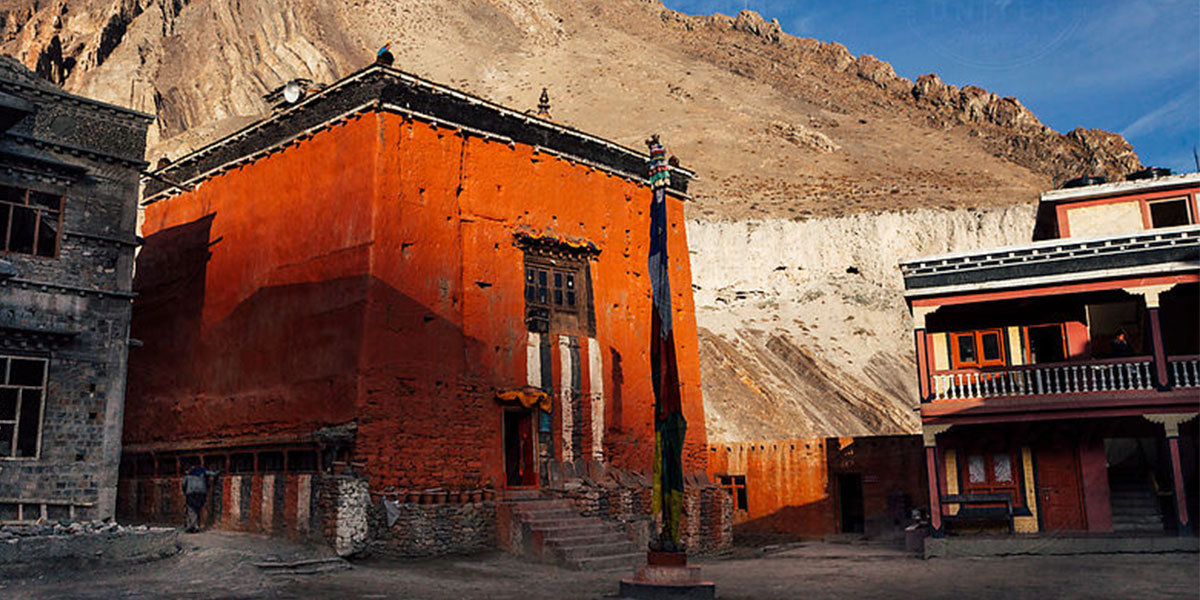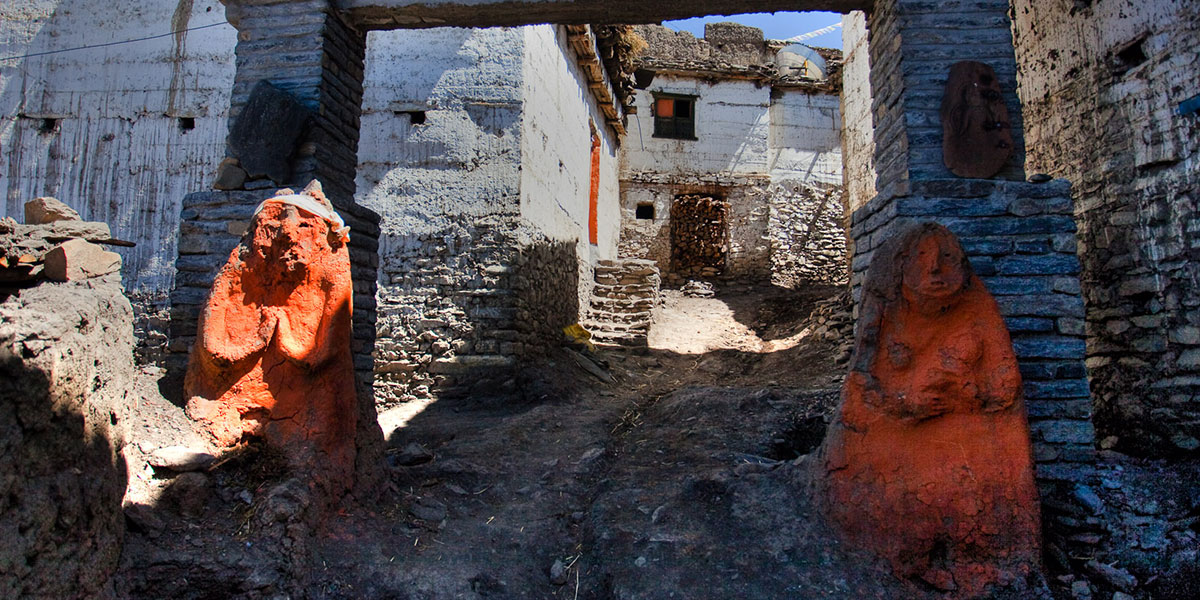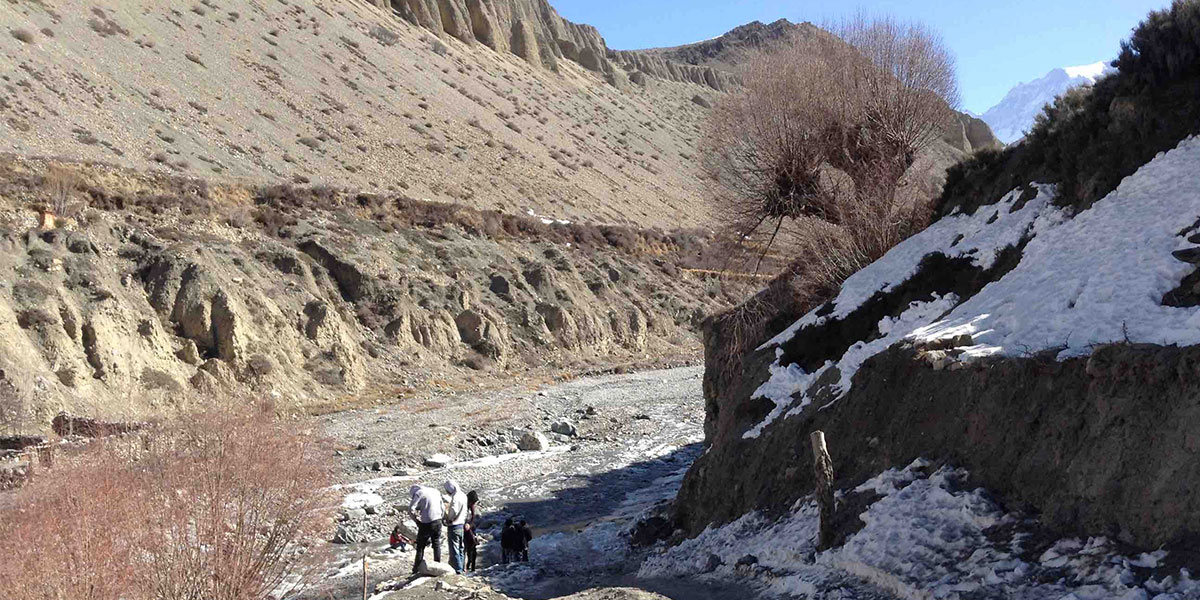It is one of the important Shakya Pa sect monasteries in Baarah Gaun region. Kag Chode Thupten Samphel Ling translates as "monastery of the place to stop and develop concentration on teachings of lord Buddha". The renowned Shakya scholar Tenpai Gyaltsen of Tibet founded the monastery in 1429. Until middle of 18th century, this monastery housed nearly 100 monks from 12 surrounding villages. The altar of monastery displays bronze icons of Sakyamuni Buddha flanked by his disciples Sariputra and Maudgalanya and other divinities, Thankas, holy canon, frescoes, and fine woodwork. Visitors have to pay certain fee to enter the monastery.
Upon its founding, Kagbeni was surrounded by a defensive wall. Originally there were two entry-exit gates in this wall, both of which were guarded by the people. About a century ago, two Khenis (lit. the ghost eaters) representing a man and a woman replaced the human guards. These grotesque primitive figures, reflecting age-old animist belief, can be seen standing welcoming you till this day. Aminism was practiced here long before the advent of Tibetan Buddhism in 11th or 12th century.
This is the ruined palace of Kag Khar dynasty that used to house 108 rooms.
Historically, Kagbeni used to be an important fortified palace along the "Salt Trade Route". Even at present, the layout of the town bears testimony of war and reflects its border position. The dark alleys give way to small interior courtyards. The streets and the tunnels appear to wind their way through the sturdy whitewashed houses of the old town, constructed as a fortress as a means of defense against wind and bandits. The ruins of this old fort at the centre symbolizes the fact that this was once an important place located strategically at the junction of two valleys; Mustang and Muktinath.
It is a shrine of Guru Rimpoche (Padmasambhava) located near secondary school south west of Kagbeni. Guru Rimpoche built this Chhorten in order to protect the village from the ghosts. The Chhorten houses idols of Guru Rimpoche and other deities.
It is a small private monastery owned by Red House Lodge in Kagbeni. The chapel houses a huge clay idol of Maitreya, thesecond largest (the largest is Jhampa Gompa in Lomanthang) in Mustang. The Tibetan name is Jhampa that translates as Future Budhha. It also depicts a big Mandala along with beautiful wall printings.
Eye catching views of the impressive huge Chhortens, traditional flat mud roofed houses with prayer flags and Mhanes on the roof, old women weaving and gossiping in their traditional costume are some of the other main attractions. Besides, Kagbeni provides spectacular views of Mt. Nilgiri (7,060m), Tilicho Peak (7,139m), Yak Kawa (6,482m), Thorung Peak (6488m), Tiri village and Samdup Choedhing Gompa.
Kagbeni celebrates four annual festivals, Chhongu (New Year) in January, Dhajyang in April/May, Fangel in August and Yartung immediately after Fangel. Chhongu is celebrated for 7 days while Dhajyang for 5 days. During these festivals men test their skills in bow and arrows with a belief that good performance ensures success in the years to come. Fangel is celebrated for good health while Yartung is traditional horse racing festival. Men in their traditional costume dance praising Kag Khar (royal family) and villagers which is called Bhatein Shyak. Feasting, merry making and drinking local beer -Chhyangis an integral part of all these festivals.
This is a holy Buddhist cave located near Phalyak and Dhakarjhong villages, about two and half-hours walk from Kagbeni. Local people believe that deity of this cave stays there in summer and in Gurusangbo Cave (near Kobang) in winter. Many Buddhist pilgrims visit the cave each year and worship here for rain. Padmasambhava (Guru Rimpoche) is said to have meditated in this cave.
This is a site of very interesting archeological excavation, where some of most important findings for Mustang's archeology have been made. Some of the findings are displayed in Mustang Eco Museum in Puthang, Jomsom airport (Five minutes walk south from Jomsom airport). The ruined settlements and caves stand as the evidence to ancient civilization of the Muktinath valley. Apparently, the present Kagbeni was shifted from here. It is about an hour walk along Jhong River, located opposite to Khinga.



